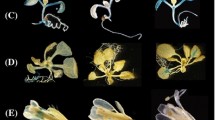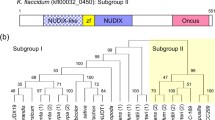Abstract
Vitamin B6 (pyridoxal phosphate) is an essential cofactor in enzymatic reactions involved in numerous cellular processes and also plays a role in oxidative stress responses. In plants, the pathway for de novo synthesis of pyridoxal phosphate has been well characterized, however only two enzymes, pyridoxal (pyridoxine, pyridoxamine) kinase (SOS4) and pyridoxamine (pyridoxine) 5′ phosphate oxidase (PDX3), have been identified in the salvage pathway that interconverts between the six vitamin B6 vitamers. A putative pyridoxal reductase (PLR1) was identified in Arabidopsis based on sequence homology with the protein in yeast. Cloning and expression of the AtPLR1 coding region in a yeast mutant deficient for pyridoxal reductase confirmed that the enzyme catalyzes the NADPH-mediated reduction of pyridoxal to pyridoxine. Two Arabidopsis T-DNA insertion mutant lines with insertions in the promoter sequences of AtPLR1 were established and characterized. Quantitative RT-PCR analysis of the plr1 mutants showed little change in expression of the vitamin B6 de novo pathway genes, but significant increases in expression of the known salvage pathway genes, PDX3 and SOS4. In addition, AtPLR1 was also upregulated in pdx3 and sos4 mutants. Analysis of vitamer levels by HPLC showed that both plr1 mutants had lower levels of total vitamin B6, with significantly decreased levels of pyridoxal, pyridoxal 5′-phosphate, pyridoxamine, and pyridoxamine 5′-phosphate. By contrast, there was no consistent significant change in pyridoxine and pyridoxine 5′-phosphate levels. The plr1 mutants had normal root growth, but were significantly smaller than wild type plants. When assayed for abiotic stress resistance, plr1 mutants did not differ from wild type in their response to chilling and high light, but showed greater inhibition when grown on NaCl or mannitol, suggesting a role in osmotic stress resistance. This is the first report of a pyridoxal reductase in the vitamin B6 salvage pathway in plants.










Similar content being viewed by others
References
Bilski P, Li MY, Ehrenshaft M, Daub ME, Chignell CF (2000) Vitamin B6 (pyridoxine) and its derivatives are efficient singlet oxygen quenchers and potential fungal antioxidants. Photochem Photobiol 71:129–134
Capitani G, Hohenester E, Feng L, Storici P, Kirsch JF, Jansonius JN (1999) Structure of 1-aminocyclopropane-1-carboxylate synthase, a key enzyme in the biosynthesis of the plant hormone ethylene. J Mol Biol 294:745–756
Chen H, Xiong L (2005) Pyridoxine is required for post-embryonic root development and tolerance to osmotic and oxidative stress. Plant J 44:396–408
Denslow SA, Walls AA, Daub ME (2005) Regulation of biosynthetic genes and antioxidant properties of vitamin B6 vitamers during plant defense responses. Physiol Mol Plant Pathol 66:244–255
Denslow SA, Rueschhoff EE, Daub ME (2007) Regulation of the Arabidopsis thaliana vitamin B6 biosynthesis genes by abiotic stress. Plant Physiol Biochem 45:152–161
Drewke C, Leistner E (2001) Biosynthesis of vitamin B6 and structurally related derivatives. In: Litwack G, Begley T (eds) Vitamins and hormones. Advances in research and applications, vol 61. Academic Press, San Diego, pp 121–155
Ehrenshaft M, Bilski P, Li MY, Chignell CF, Daub ME (1999) A highly conserved sequence is a novel gene involved in de novo vitamin B6 biosynthesis. Proc Natl Acad Sci USA 96:9374–9378
Fitzpatrick TB, Amrhein N, Kappes B, Macheroux P, Tews I, Raschle T (2007) Two independent routes of de novo vitamin B6 biosynthesis: not that different after all. Biochem J 407:1–13
Gonzalez E, Danehower DA, Daub M (2007) Vitamer levels, stress response, enzyme activity, and gene regulation of Arabidopsis lines mutant in the pyridoxine/pyridoxamine 5′ -phosphate oxidase (PDX3) and the pyridoxal kinase (SOS4) genes involved in the vitamin B6 salvage pathway. Plant Physiol 145:985–996
Graham CM, Ehrenshaft M, Hausner G, Reid DM (2004) A highly conserved gene for vitamin B6 biosynthesis may have consequences for stress and hormone responses in plants. Physiol Plant 121:8–14
Guirard BM, Snell EE (1988) Physical and kinetic properties of a pyridoxal reductase purified from baker’s yeast. Biofactors 1:187–192
Havaux M, Ksas B, Szewczyk A, Rumeau D, Franck F, Caffarri S, Triantaphylides C (2009) Vitamin B6 deficient plants display increased sensitivity to high light and photo-oxidative stress. BMC Plant Biol 9:130
Laemmli UK (1970) Cleavage of structural proteins during the assembly of the head of bacteriophage T4. Nature 227:680–685
Leuendorf JE, Genau A, Szewczyk A, Mooney S, Drewke C, Leistner E, Hellmann H (2008) The PDX1 family is structurally and functionally conserved between Arabidopsis thaliana and Ginkgo biloba. FEBS J 275:960–969
Livak KJ, Schmittgen TD (2001) Analysis of relative gene expression data using real-time quantitative PCR and the 2−ΔΔCT method. Methods 25:402–408
Lum HK, Kwok F, Lo SCL (2002) Cloning and characterization of Arabidopsis thaliana pyridoxal kinase. Planta 215:870–879
McCormick DB, Merrill AHJ (1980) Pyridoxamine (pyridoxine) 5′-phosphate oxidase. In: Tryfiates GP (ed) Vitamin B6 metabolism and role in growth. Food & Nutrition Press, Inc., Westport, pp 1–26
Mittenhuber G (2001) Phylogenetic analyses and comparative genomics of vitamin B6 (pyridoxine) and pyridoxal phosphate biosynthesis pathways. J Mol Microbiol Biotechnol 3:1–20
Mooney S, Leuendorf JE, Hendrickson C, Hellmann H (2009) Vitamin B6: a long known compound of surprising complexity. Molecules 14:329–351
Morita T, Takegawa K, Yagi T (2004) Disruption of the plr1 + gene encoding pyridoxal reductase of Schizosaccharomyces pombe. J Biochem 135:225–230
Nakano M, Morita T, Yamamoto T, Sano H, Ashiuchi M, Masui R, Kuramitsu S, Yagi T (1999) Purification, molecular cloning, and catalytic activity of Schizosaccharomyces pombe pyridoxal reductase—a possible additional family in the aldo-keto reductase superfamily. J Biol Chem 274:23185–23190
Ollilainen V (1999) HPLC analysis of vitamin B6 in foods. Agric Food Sci Finland 8:515–618
Penning TM (2004) Introduction and overview of the aldo-keto reductase superfamily. In: Penning TM, Petrash JM (eds) Aldo-keto reductases and toxicant metabolism. American Chemical Society Symposium Series, vol 865, pp 3–20
Preiss J, Ball K, Hutney J, Smith-White B, Li L, Okita TW (1991) Regulatory mechanisms involved in the biosynthesis of starch. Pure Appl Chem 63:535–544
Saitou N, Nei M (1987) The neighbor-joining method: a new method for reconstructing phylogenetic trees. Mol Biol Evol 4:406–425
Sang Y, Barbosa JM, Wu H, Locy RD, Singh NK (2007) Identification of a pyridoxine (pyridoxamine) 5′-phosphate oxidase from Arabidopsis thaliana. FEBS Lett 581:344–348
Sang Y, Locy RD, Goertzen LR, Rashotte AM, Si Y, Kang K, Singh NK (2011) Expression, in vivo localization and phylogenetic analysis of a pyridoxine 5′-phosphate oxidase in Arabidopsis thaliana. Plant Physiol Biochem 49:88–95
Schmid M, Davison TS, Henz SR, Pape UJ, Demar M, Vingron M, Schölkopf B, Weigel D, Lohmann JU (2005) A gene expression map of Arabidopsis thaliana development. Nat Genet 37:501–506
Shi H, Xiong L, Stevenson B, Lu T, Zhu JK (2002) The Arabidopsis salt overly sensitive 4 mutants uncover a critical role for vitamin B6 in plant salt tolerance. Plant Cell 14:575–588
Shimomura S, Emman K, Fukui T (1980) The role of pyridoxal 5′-phosphate in plant phosphorylase. J Biochem 87:1043–1052
Takagi M, Shimomura S, Fukui T (1981) Function of the phosphate group of pyridoxal 5′-phosphate in the glycogen phosphorylase reaction. J Biol Chem 256:728–730
Tambasco-Studart M, Titiz O, Raschle T, Forster G, Amrhein N, Fitzpatrick TB (2005) Vitamin B6 biosynthesis in higher plants. Proc Natl Acad Sci USA 102:13687–13692
Tambasco-Studart M, Tews I, Amrhein N, Fitzpatrick TB (2007) Functional analysis of PDX2 from Arabidopsis, a glutaminase involved in vitamin B6 biosynthesis. Plant Physiol 144:915–925
Thompson JD, Higgins DG, Gibson TJ (1994) CLUSTAL W: improving the sensitivity of progressive multiple sequence alignment through sequence weighting, position-specific gap penalties and weight matrix choice. Nucl Acids Res 22:4673–4680
Titiz O, Tambasco-Studart M, Warzych E, Apel K, Amrhein N, Laloi C, Fitzpatrick TB (2006) PDX1 is essential for vitamin B6 biosynthesis, development and stress tolerance in Arabidopsis. Plant J 48:933–946
Tsang EWT, Hu Z, Chang Q, McGregor DI, Keller WA (2003) Expression of a Brassica napus glutamate 1-semialdehyde aminotransferase in Escherichia coli and characterization of the recombinant protein. Prot Expr Purif 29:193–201
Valls F, Sancho MT, Fernando-Muino MA, Checa MA (2001) Determination of vitamin B6 in cooked sausages. J Agric Food Chem 49:38–41
Wang H, Liu D, Liu C, Zhang A (2004) The pyridoxal kinase gene TaPdxK from wheat complements vitamin B6 synthesis-defective Escherichia coli. J Plant Physiol 161:1053–1060
Weigel D, Glazebrook J (2002) Arabidopsis: A laboratory manual. Cold Spring Harbor Laboratory Press, Cold Spring Harbor
Winkler ME (2000) Genetic and genomic approaches for delineating the pathway of pyridoxal 5′-phosphate coenzyme biosynthesis in Escherichia coli. In: Iriarte AJ, Kagan HM, Martinez-Carrion M (eds) Biochemistry and molecular biology of vitamin B6 and PQQ-dependent Proteins. Birkhauser Verlag, Basel, pp 3–10
Zybailov B, Rutschow H, Friso G, Rudella A, Emanuelsson O, Sun Q, van Wijk KJ (2008) Sorting signals, N-terminal modifications and abundance of the chloroplast proteome. PLoS ONE 3:e1994
Acknowledgments
This work was supported in part by grant MCB-0322562 from the National Science Foundation and from the North Carolina Agricultural Research Service.
Author information
Authors and Affiliations
Corresponding author
Electronic supplementary material
Below is the link to the electronic supplementary material.
Rights and permissions
About this article
Cite this article
Herrero, S., González, E., Gillikin, J.W. et al. Identification and characterization of a pyridoxal reductase involved in the vitamin B6 salvage pathway in Arabidopsis. Plant Mol Biol 76, 157–169 (2011). https://doi.org/10.1007/s11103-011-9777-x
Received:
Accepted:
Published:
Issue Date:
DOI: https://doi.org/10.1007/s11103-011-9777-x




